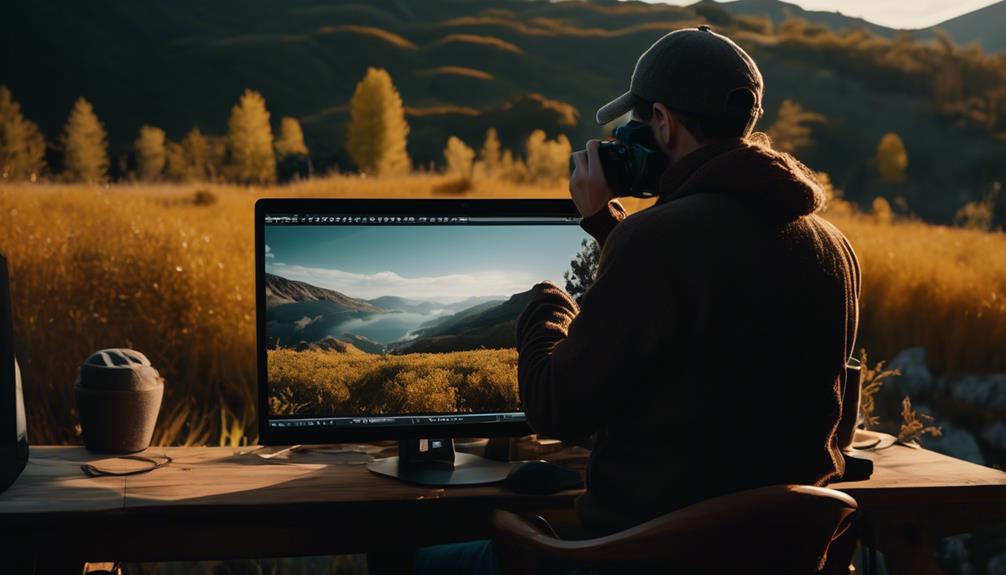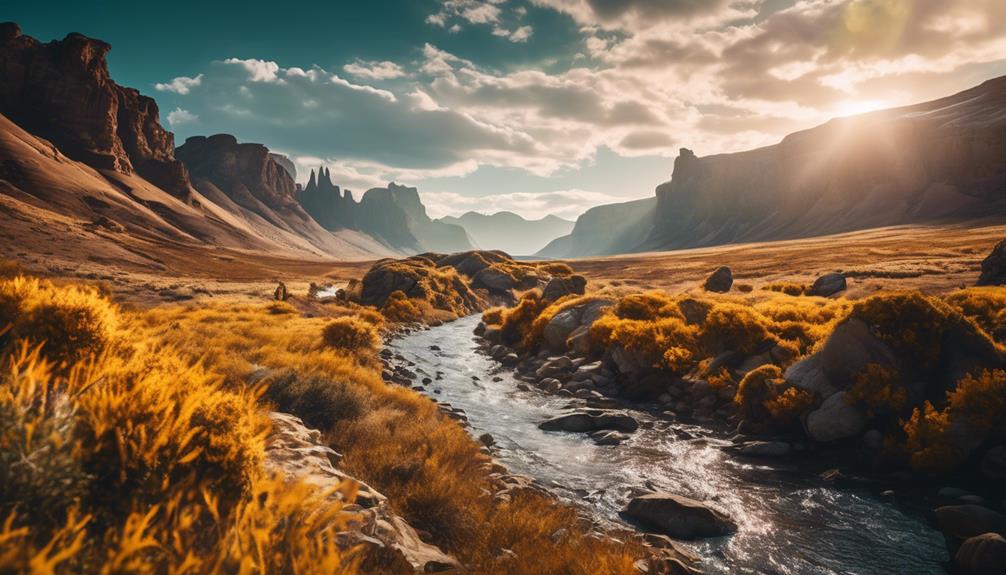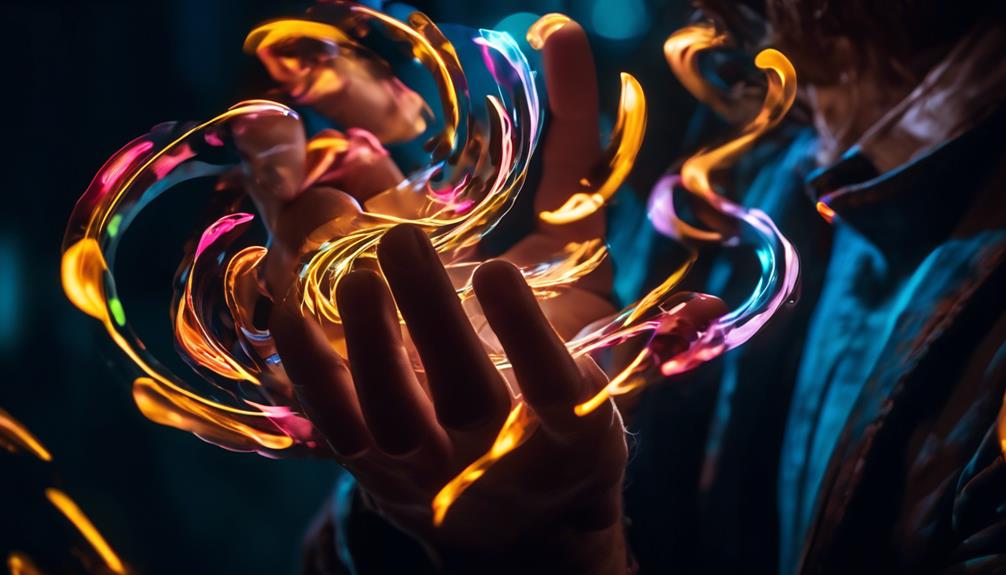Please note this post may contain affiliate links picked by me (Jay) that I have deemed may be of interest or relevant to you the reader of this.
These links do not affect the cost of the thing if you decide to purchase but i may get a little money if you choose to purchase.
For more information on my affiliate link policy click here.
Have you ever wondered how professional photographers make their images come to life? It's as if their photos have a secret touch, a magical transformation that sets them apart from the rest.
Well, my friend, today is your lucky day. In this trustworthy guide, I will unveil the genuine post-processing tricks that will elevate your photography game to a whole new level.
From basic adjustments to advanced color grading, from creative filters to professional retouching techniques, I've got you covered.
So, get ready to unlock the secrets of post-processing and take your photography to the next level.
Key Takeaways
- Mastering basic adjustments such as white balance and exposure can greatly enhance the quality and natural look of your photos.
- Creative filters and effects can be used to add artistic expressions and create unique interpretations of your photos.
- Professional retouching techniques can help enhance the beauty of portraits while maintaining a natural look.
- Advanced color grading techniques can be used to create impactful visual storytelling and evoke specific moods in your photos.
Basic Adjustments for Enhancing Your Photos
To take your photographs to the next level, I highly recommend mastering the art of basic adjustments for enhancing your photos. These adjustments include white balance correction and exposure adjustment.
White balance correction is crucial because it ensures that the colors in your photos appear accurate and natural. Have you ever taken a photo indoors and noticed that it had an orange or blue tint? That's because of incorrect white balance. By adjusting the white balance, you can eliminate these unwanted color casts and bring out the true colors of your subject.
Exposure adjustment, on the other hand, allows you to control the brightness and darkness of your photos. It's all about finding the right balance of light and shadow. Overexposed photos can appear washed out and lack detail, while underexposed photos can look too dark and lose important elements. By adjusting the exposure, you can bring back details in the highlights and shadows, creating a more balanced and visually appealing image.
Mastering these basic adjustments will give you the power to transform your photos and bring out their full potential. So, don't underestimate the importance of white balance correction and exposure adjustment. Start experimenting with these techniques, and you'll be amazed at the difference they can make in your photography.
Get ready to elevate your photos to a whole new level of brilliance!
Creative Filters and Effects for Artistic Expressions
Let's dive into the exciting world of creative filters and effects, where you can unleash your artistic expressions and take your photography to new heights. With the right post-processing techniques, you can create abstract compositions using filters and effects that transform your ordinary photos into extraordinary works of art.
One of the most fascinating aspects of creative filters and effects is the ability to create surrealistic interpretations through post-processing. By experimenting with different filters and effects, you can add a dreamlike quality to your images, blurring the lines between reality and imagination. Whether it's adding a vintage film effect, applying a painterly texture, or distorting reality with a kaleidoscope filter, the possibilities are endless.
Abstract compositions using filters and effects allow you to break free from the constraints of traditional photography and explore new possibilities. You can play with colors, textures, and shapes to create unique and visually striking images that captivate the viewer's attention. By experimenting with different combinations of filters and effects, you can create a truly original and personalized style.
Professional Retouching Techniques for Stunning Portraits
I love using professional retouching techniques to enhance the beauty and create stunning portraits that leave a lasting impression. When it comes to capturing the essence of a person, advanced skin retouching is crucial. This technique allows me to smooth out imperfections while maintaining a natural look. By carefully adjusting the tone and texture of the skin, I can bring out the best in my subjects and create flawless portraits.
In addition to advanced skin retouching, I also incorporate fine art photography techniques in my portrait editing. These techniques involve playing with light and shadow, color grading, and adding artistic touches to create a unique and captivating image. By experimenting with various editing tools and effects, I'm able to transform a simple portrait into a work of art.
One of my favorite techniques is the use of selective editing. This allows me to focus on specific areas of the portrait and make targeted adjustments. Whether it's enhancing the eyes, smoothing out wrinkles, or adding a touch of warmth to the skin, selective editing gives me complete control over the final result.
Professional retouching techniques not only elevate the overall quality of my portraits but also give me the creative freedom to express my vision. With the right skills and tools, I can transform a good portrait into an extraordinary one, leaving my clients in awe.
Advanced Color Grading for Impactful Visual Storytelling
Color grading is a powerful technique that can greatly enhance the impact and storytelling of your photographs. It goes beyond simply correcting colors; it allows you to create a specific mood and atmosphere that aligns with your creative vision.
To take your color grading to the next level and create impactful visual narratives, consider incorporating these advanced techniques:
- Advanced lighting techniques for dramatic visual narratives: Experiment with different lighting setups and techniques to create unique and compelling visuals. Play with shadows and highlights to add depth and dimension to your images. Use techniques like rim lighting or chiaroscuro to create dramatic effects that draw the viewer's attention.
- Composition and framing strategies for powerful storytelling in color grading: Composition plays a crucial role in storytelling. Pay attention to the placement of elements within the frame and use leading lines, rule of thirds, and framing techniques to guide the viewer's eye and create a sense of narrative. Experiment with different perspectives and angles to add visual interest and emphasize the mood you want to convey.
- Experiment with color palettes and tonal adjustments: Color grading is all about creating a specific mood or atmosphere, and the choice of color palettes and tonal adjustments can greatly impact the overall feel of your image. Play with contrasting colors to create visual tension or use a monochromatic color scheme to evoke a certain emotion. Adjust the overall tonal range to enhance the mood and emphasize specific elements within the frame.
Workflow Optimization Tips for Efficient Post-Processing
To optimize your post-processing workflow and achieve efficient results, consider implementing these time-saving tips and techniques.
One of the most effective ways to streamline your workflow is by utilizing batch processing. This technique allows you to apply the same edits to multiple images simultaneously, saving you valuable time and effort. With batch processing, you can easily adjust exposure, color balance, and other settings across a series of photos with just a few clicks.
Another crucial aspect of workflow optimization is file organization. Keeping your files organized and properly labeled will make it easier to locate and work with them later on. Create a logical folder structure and use descriptive file names to ensure that you can quickly find the images you need. Consider using software that allows you to add keywords and tags to your files, making it even easier to search and sort them.
Additionally, it's essential to establish a consistent post-processing routine. Develop a step-by-step process that you can follow for each image, from importing to exporting. This will help you stay focused and ensure that you don't overlook any crucial adjustments. By establishing a consistent workflow, you'll be able to work more efficiently and produce consistent results.
Frequently Asked Questions
How Can I Avoid Overediting My Photos and Maintain a Natural Look?
To avoid overediting my photos and maintain a natural look, I've learned some useful tricks.
Firstly, I focus on enhancing details without going overboard. This involves adjusting the brightness, contrast, and saturation in moderation.
Secondly, I understand the importance of white balance in achieving a natural look. By correctly setting the white balance, I can ensure that the colors in my photos appear true to life.
These techniques have helped me create stunning images while maintaining a genuine and natural aesthetic.
Are There Any Specific Filters or Effects That Work Best for Landscape Photography?
Are there specific filters or effects that work best for landscape photography?
Oh, you betcha! When it comes to capturing those awe-inspiring landscapes, there are a couple of tricks up my sleeve.
First, let's talk about long exposure effects. Using techniques like neutral density filters or stacking multiple exposures, you can create dreamy, ethereal scenes with silky smooth water or streaking clouds.
And if you're into black and white landscapes, post-processing is your best friend! Play around with contrast, shadows, and highlights to create stunning monochrome masterpieces.
Happy shooting!
What Are Some Common Mistakes to Avoid When Retouching Portraits?
When retouching portraits, there are some common mistakes that can make the edits look unnatural.
One tip for achieving natural looking edits is to avoid over-smoothing the skin, as it can result in a plastic appearance.
Another mistake to avoid is excessive whitening of the teeth and eyes, as it can make them look unnaturally bright.
It's also important to be mindful of not overdoing the frequency separation technique, as it can lead to overly blurred details.
How Can I Use Color Grading to Enhance the Mood and Atmosphere in My Photos?
When it comes to enhancing the mood and atmosphere in your photos, color grading is a powerful tool. By manipulating the colors and tones, you can evoke specific emotions and tell a story through your post-processing.
The impact of post-processing on storytelling can't be overstated. With the right color grading techniques, you can create a sense of warmth, mystery, or even nostalgia in your images.
Are There Any Recommended Software Plugins or Tools for Streamlining the Post-Processing Workflow?
There are definitely some recommended tools and efficient software plugins that can streamline your post-processing workflow. These tools can help you save time and achieve professional-looking results.
From image editing software like Adobe Lightroom and Photoshop to plugins like Nik Collection and Topaz Labs, there are plenty of options to choose from.
I've personally found these plugins to be incredibly helpful in enhancing my photos and making the editing process more efficient.
Conclusion
In conclusion, post-processing is an essential tool for new photographers to enhance their images and bring their creative visions to life. By learning and applying these genuine tricks, you can take your photography to the next level and create truly impactful and stunning visuals.
Did you know that 90% of professional photographers use post-processing techniques to elevate their work? This statistic highlights the importance of post-processing in the photography industry. It is not just a trend or a fad, but a widely accepted practice among professionals.
So don't hesitate to dive into the world of post-processing and unleash your artistic potential! With the right techniques and tools, you can transform your photos into masterpieces. Whether you want to adjust the exposure, enhance colors, or remove unwanted elements, post-processing allows you to make these changes and create images that truly stand out.
So, embrace post-processing as a valuable skill in your photography journey. It is not about altering reality but rather about enhancing the beauty that already exists. Through post-processing, you can bring out the best in your images and showcase your unique vision to the world.


